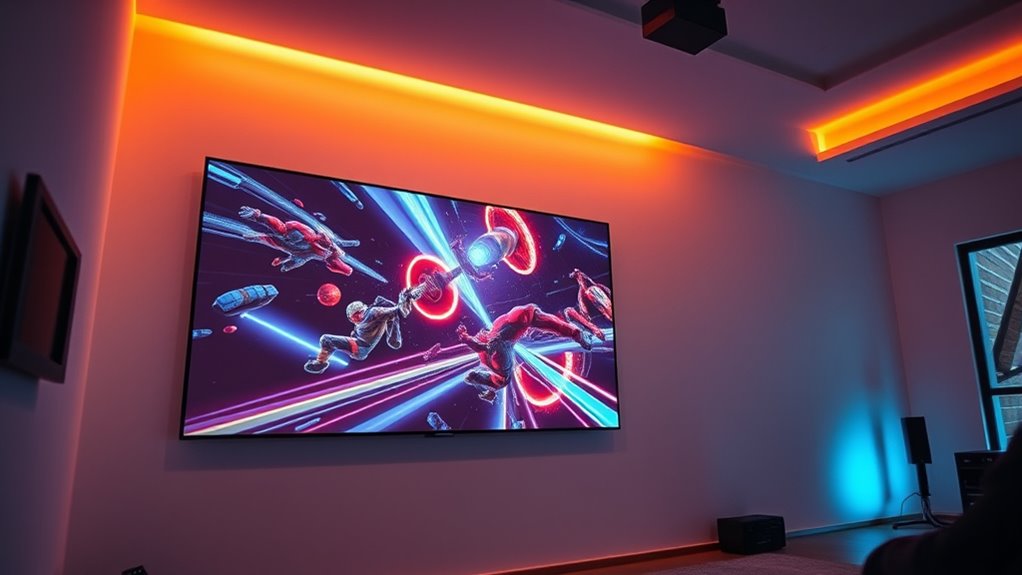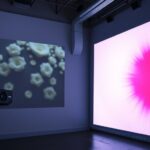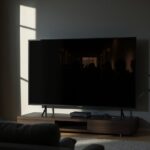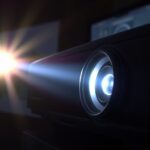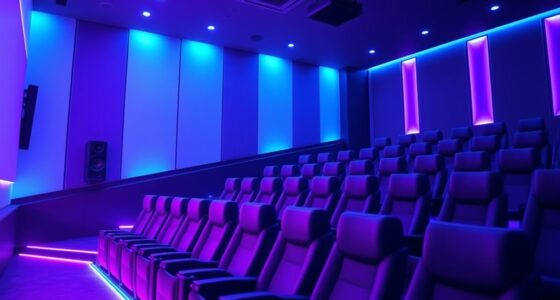To optimize your projector’s brightness for gaming, start by adjusting the controls incrementally while using scenes with both dark and bright elements. Turn off unnecessary lights and create a consistent environment to avoid washout. Increase brightness in bright rooms, but don’t go too high, or contrast will suffer. Fine-tune contrast and brightness together to preserve detail in shadows and highlights. For more detailed tips on achieving the best gaming picture, keep exploring the key adjustments.
Key Takeaways
- Adjust projector brightness based on ambient lighting, increasing in bright environments and lowering in darker rooms.
- Use test scenes with both dark and bright elements to find a balanced brightness setting.
- Fine-tune contrast alongside brightness to enhance shadow detail and overall image depth.
- Create consistent lighting conditions and turn off unnecessary lights during gaming sessions.
- Regularly revisit and adjust brightness as room lighting or scene content changes for optimal visuals.

Are you unsure how to adjust your projector’s brightness for the best viewing experience? Getting the perfect brightness setting can make a huge difference in your gaming sessions, and it all starts with understanding calibration techniques and ambient light considerations. Calibration techniques involve fine-tuning your projector’s settings to match your environment, ensuring images are vibrant without being washed out or too dim. Before you begin, turn off all unnecessary lights and close curtains or blinds if possible, so you can accurately assess how your projector performs in your typical gaming environment. This step helps you determine the right baseline for brightness and contrast adjustments.
Next, access your projector’s menu and locate the brightness and contrast controls. Adjust these settings incrementally, observing how the image quality changes. Your goal is to find a balance where dark scenes retain detail without appearing murky or overly bright scenes losing their depth. Remember, calibration techniques often involve testing with specific images or game scenes that contain a mix of dark and bright elements. This process helps you identify the essential brightness level that preserves details across different game genres, whether you’re immersed in shadowy stealth missions or vibrant, high-energy battles. Additionally, understanding the role of contrast ratio can further enhance your image quality by improving the distinction between light and dark areas.
Ambient light considerations are vital in this process because the amount of surrounding light directly impacts how you should set your projector’s brightness. If your gaming room has a lot of ambient light, you’ll need to increase brightness to counteract the washout caused by external light sources. Conversely, in a darker room, lower brightness settings can enhance contrast and reduce eye strain. Think about your typical gaming environment and adjust accordingly. If you often play during the day with sunlight streaming in, consider using blackout curtains or blinds to help maintain consistent viewing conditions, making it easier to fine-tune your projector settings.
Another tip is to do a final check after making adjustments by playing a familiar game scene. Keep an eye on how well you can distinguish details in both dark and bright areas. If dark scenes look flat or details are lost, try increasing the brightness slightly; if images look overly bright and lose contrast, dial it back. Remember, the goal isn’t just to make the image as bright as possible but to achieve a balanced picture that enhances your gaming experience. Regularly revisit your settings as lighting conditions change or when you switch to different rooms, ensuring your calibration remains ideal for your gaming environment.
Frequently Asked Questions
How Does Ambient Light Affect Projector Brightness Choices?
Ambient light markedly impacts your projector brightness adjustment choices. In a bright room, you need to increase brightness to keep the image clear and vibrant, preventing it from looking washed out. Conversely, in darker environments, lower brightness settings work well, reducing eye strain and saving energy. Always assess your ambient light impact before adjusting your projector’s brightness, ensuring ideal image quality and an enjoyable gaming experience.
What’s the Ideal Brightness Setting for Different Gaming Genres?
Imagine your gaming world in perfect harmony—your brightness should match the genre. For fast-paced shooters, keep brightness high to enhance visibility, while lower settings work better for story-driven RPGs to prevent eye strain. Remember, proper color calibration and sharp screen resolution make these settings shine. Adjust your projector’s brightness to create an immersive experience, ensuring every detail pops, whether you’re battling enemies or exploring new worlds.
Can Adjusting Brightness Improve Image Contrast During Gaming?
Adjusting brightness can improve your image contrast during gaming, making visuals pop and enhancing color accuracy. When you fine-tune your projector’s brightness, you reduce eye strain by avoiding overly bright or dark scenes. This balance helps you see details clearly without fatigue. So, experiment with your settings to find the right brightness level, ensuring sharp contrast and comfortable viewing, especially during long gaming sessions.
How Often Should I Recalibrate My Projector’s Brightness?
Think of your projector’s brightness calibration like tuning a musical instrument—it needs regular attention to stay in harmony. You should recalibrate every 3 to 6 months to maintain brightness consistency and guarantee ideal image quality. Factors like changing bulbs, room lighting, and usage can affect performance. Regular calibration keeps your gaming visuals sharp and vibrant, preventing dullness or glare from sneaking in, much like tuning a guitar keeps the music sweet.
Does Higher Brightness Impact Projector Bulb Lifespan?
Higher brightness can impact your projector bulb’s lifespan because it increases bulb temperature and power consumption. When you set your projector to a high brightness level, the bulb works harder, generating more heat, which accelerates wear and shortens its life. To extend your bulb’s life, keep brightness at a moderate level, guarantee proper ventilation, and avoid prolonged use at maximum brightness settings.
Conclusion
In summary, adjusting your projector’s brightness settings can considerably enhance your gaming experience. Did you know that gamers who optimize their projector brightness report up to 30% better image clarity? By fine-tuning these settings, you’ll enjoy sharper visuals and more immersive gameplay. Don’t settle for default settings—take a moment to customize your brightness for the best possible experience. Your gaming sessions will never be the same once you find that perfect balance.
